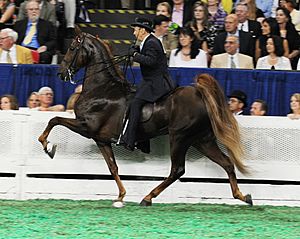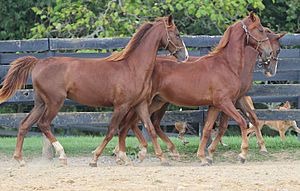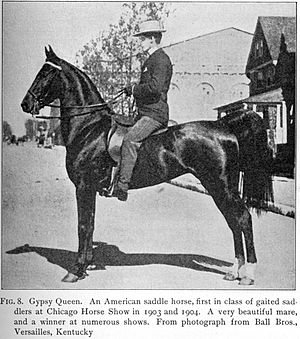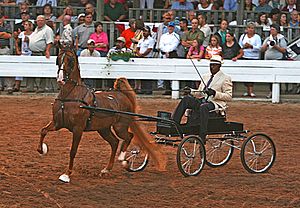American Saddlebred facts for kids
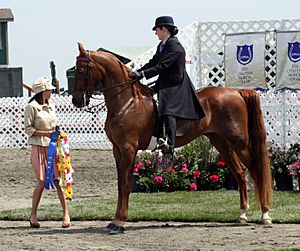
An American Saddlebred and rider in saddle seat tack and attire.
|
|
| Distinguishing features | High stepping with exaggerated action |
|---|---|
| Alternative names | Saddlebred, American Saddle Horse, American Saddler |
| Country of origin | United States (Kentucky) |
| Common nicknames | "Peacock of the Horse World" |
| Breed standards | |
| American Saddlebred Horse Association | Breed standards |
| Horse (Equus ferus caballus) | |
The American Saddlebred is a special horse breed from the United States. People often call it the "Horse America Made." This breed comes from riding horses that were popular around the time of the American Revolution. Its ancestors include horses like the Narragansett Pacer, Canadian Pacer, Morgan, and Thoroughbred.
The American Saddlebred became the horse we know today in Kentucky. It was once known as the "Kentucky Saddler." This horse was very important during the American Civil War, often used by officers. In 1891, a special group was formed in the United States to keep track of the breed.
During the 1900s, the Saddlebred became very popular in the US. It was also sent to countries like South Africa and Great Britain. Since the first group was formed, almost 250,000 American Saddlebreds have been officially recorded. You can now find them all over the world. Other countries like Great Britain, Australia, Europe, and southern Africa also have groups for the breed.
Saddlebreds are usually about 15 to 16 hands tall. They are known for looking very stylish and having a proud way of moving. They are also spirited but gentle. These horses can be almost any color, including pinto patterns. Pinto colors have been seen in the breed since the late 1800s.
Saddlebreds are known as a gaited breed. This means some of them are trained to do special four-beat gaits. One is a "slow gait" and another is a much faster "rack."
Many famous people have owned and shown Saddlebreds. These horses have also appeared in movies, especially during the Golden Age of Hollywood. Saddlebreds are most famous for their performances in horse shows. But they can also compete in other English riding sports and combined driving. They are also great horses for pleasure riding.
American Saddlebreds often compete in five main types of shows: Five-Gaited, Three-Gaited, Fine Harness, Park, and Pleasure. In these shows, judges look at how they perform, their manners, how they look, their quality, and their body shape.
Contents
What Makes Them Special?
American Saddlebreds are usually between 15 and 17 hands tall. Most are about 15 to 16 hands. They weigh between 1000 and 1200 pounds. These horses have nicely shaped heads with a straight nose. They have long, slim, arched necks and strong, level backs. Their shoulders slope well, and their legs are correctly formed. The tail is carried high.
People who love Saddlebreds say they are spirited but gentle. They can be any color. The most common colors are chestnut, bay, brown, and black. Some are also gray, roan, palomino, and pinto. The first known pinto Saddlebred was a male horse born in 1882.
Admirers call the Saddlebred the "world's most beautiful horse." It is also known as the "peacock of the horse world." The United States Equestrian Federation (USEF) describes them as having a special "class," "presence," or "style." This special look makes their every movement stand out.
Saddlebreds are very popular show horses. They are shown in saddle seat style in both three-gaited and five-gaited classes. Three-gaited horses perform the walk, trot, and canter. These are the common gaits for most horse breeds. Five-gaited horses do the three regular gaits, plus two special four-beat gaits. These are called the slow gait and the rack.
The slow gait is a four-beat gait where the legs on the same side move together. But they hit the ground at different times. The back foot lands slightly before the front foot. In shows, this gait should be smooth and controlled. The rack is also a four-beat gait. But all four hoofbeats are evenly spaced. In shows, the rack is performed with lots of speed and energy.
A Look at Their History
The Saddlebred's story begins with horses from the British Isles. These were called Galloway and Hobby horses. They had special ambling gaits. Early settlers brought these horses to the United States.
These horses were later improved in America. They became a breed called the Narragansett Pacer, which no longer exists. This breed was known for its ambling and pacing gaits. When colonists brought Thoroughbreds to America, they were bred with the Narragansett Pacer. This, along with many horses being sent away, led to the Narragansett breed disappearing. To keep important bloodlines, Canadian Pacers were brought in.
By the time of the American Revolution, a new type of riding horse had appeared. It had the size and quality of the Thoroughbred. But it also had the ambling gaits and strength of the Pacer breeds. This horse was called the American Horse. It was first mentioned in a letter in 1776. An American diplomat asked for one to be sent to France as a gift for Marie Antoinette.
The 1800s
Other breeds helped develop the Saddlebred in the 1800s. These include the Morgan, Standardbred, and Hackney. The Canadian Pacer was especially important. This breed, originally from France, also helped create the Standardbred and Tennessee Walking Horse. A very important Canadian Pacer for Saddlebreds was Tom Hall. He was a blue roan male horse born in 1806. He was brought to the US from Canada. He became a key ancestor for many Saddlebred lines.
The American Horse was further improved in Kentucky. More Thoroughbred blood was added. This created a taller, better-looking horse. It became known as the Kentucky Saddler. The breed's official group first listed 17 main male horses. But by 1908, they decided to list only one.
Today, two main male horses are recognized as founders of the breed. Both were crosses with Thoroughbreds. The first was Denmark. His son, Gaines' Denmark, is in the family tree of over 60 percent of the horses in the breed's first official books. A second founder, Harrison Chief, was recognized in 1991. He was a descendant of the Thoroughbred Messenger. Messenger is also a founder for the Standardbred breed.
During the American Civil War, American Saddlebreds were often used by the military. They were known for being brave and strong. Many officers rode them. These included General Lee's horse Traveller and General Grant's horse Cincinnati. Other generals like William Tecumseh Sherman and Stonewall Jackson also rode them. Kentucky Saddlers were used during tough marches. Historical records show they held up better than other horse breeds.
The American Saddlebred Horse Association was formed in 1891. It was first called the National Saddle Horse Breeders Association (NSHBA). This was the first national group for an American-developed horse breed. General John Breckinridge Castleman helped create the NSHBA. In 1899, the group changed its name. It became the American Saddle Horse Breeders Association. This made it clear the breed's name was "American Saddle Horse."
From the 1900s to Today
After World War I, American Saddlebreds began to be sent to South Africa. Now, it is the most popular non-racing horse breed there. Saddlebred horse show rules kept changing through the 1920s. The breed became more and more popular.
The Saddlebred industry slowed down during World War II. But it started growing again after the war. Mexico, Missouri even earned the title "Saddle Horse Capital of the World." Exports continued. In 1949, the Saddle Horse Breeders' Society of South Africa was formed.
The 1950s saw continued growth for the Saddlebred breed. A famous horse named The Lemon Drop Kid appeared on the cover of Sports Illustrated. This was the first and only Saddlebred to do so. Later in the 1950s, the Saddle Horse Capital moved to Shelby County, Kentucky. This was thanks to successful breeders Charles and Helen Crabtree.
In 1980, the American Saddle Horse Breeder's Association changed its name. It became the American Saddlebred Horse Association (ASHA). People who didn't breed horses could now join. The group started to focus on promoting the breed. In 1985, the ASHA became the first horse breed group to have its main office at the Kentucky Horse Park in Lexington, Kentucky.
Ten years later, in 1995, a group was formed in Great Britain. It was called the United Saddlebred Association – UK. It registers Saddlebreds in Britain and works with the ASHA. Since the American group was founded, almost 250,000 horses have been recorded. Nearly 3,000 new foals are registered every year. This is the oldest horse breed group still working in the US. The breed is most common in the eastern US. But you can also find them across North America, Europe, Australia, and South Africa.
At the Kentucky Horse Park, you can find the American Saddlebred Museum. It has a large collection of items and art related to the breed. It also has a library with 2,500 books about Saddlebreds. There are many magazines about the American Saddlebred. These include Show Horse Magazine, Bluegrass Horseman, The National Horseman, Saddle and Bridle, and Show Horse International.
Show Ring History
Saddlebreds were shown in Kentucky as early as 1816. They were a big part of the first national horse show in the United States. This show was held at the St. Louis Fair in 1856. The Kentucky State Fair started a World Championship show in 1917. It offered a $10,000 prize for the best five-gaited horse. Also in 1917, the American Horse Shows Association was formed. It is now the United States Equestrian Federation. This group started to make show rules the same everywhere.
In 1957, the American Saddlebred Pleasure Horse Association was formed. It set rules for English pleasure classes. Today, the most important award in the breed is the American Saddlebred "Triple Crown." This means winning the five-gaited championships at three big shows: the Lexington Junior League Horse Show, the Kentucky State Fair World's Championship Horse Show, and the American Royal horse show. Only six horses have ever won this award.
The breed's show history also connects to big historical events. Boxing champion Joe Louis owned and showed Saddlebreds in the 1940s. He organized the first "All-Negro" horse show in Utica, Michigan. This gave African-American people more chances to show horses. This was important at a time when there was a lot of racial segregation in the United States.
How They Are Used Today
Today, Saddlebreds are shown in many different ways in the United States. They compete in in-hand classes, where they are judged on their looks. They are ridden in saddle seat classes for three- and five-gaited horses. These include Park and pleasure classes. They also compete in hunter country pleasure and western pleasure. Saddlebreds are also used for pleasure driving, fine harness, and roadster harness classes.
In five-gaited shows, they are shown with a full tail. Sometimes, an artificial switch is added to make the tail look fuller. They also have a full mane. Three-gaited horses may have a shaved "roached" mane and a full tail. The trend of trimming the hair at the top of their tails has gone out of style. Today, special tail supports are generally not allowed in Pleasure shows. Horses with natural tails are not judged negatively in any show.
Besides breed-specific shows, Saddlebreds are also good for competitive trail riding, endurance riding, dressage, combined driving, eventing, and show jumping. Because they are so well known for their traditional show ring competitions, people sometimes mistake them for other breeds when they do other horse sports. They are also great family horses for trail, pleasure riding, and even ranch work.
Famous Horses in Movies and with Celebrities
Many famous horses from the Golden Age of Hollywood movies were Saddlebreds. These include the main horses in My Friend Flicka, National Velvet, Fury, and one version of Black Beauty. A horse that was part-Saddlebred played the main role in the TV series Mr. Ed. A Saddlebred also had an important role in the movie Giant.
In the 1990s, William Shatner, a famous actor and Saddlebred breeder, rode one of his own horses in a movie. Her name was Great Belles of Fire. He rode her as James T. Kirk in Star Trek Generations. Many other famous people besides Shatner have owned and shown Saddlebreds. These include Clark Gable, Will Rogers, Joe Louis, and Carson Kressley.
See also
 In Spanish: Saddlebred americano para niños
In Spanish: Saddlebred americano para niños


